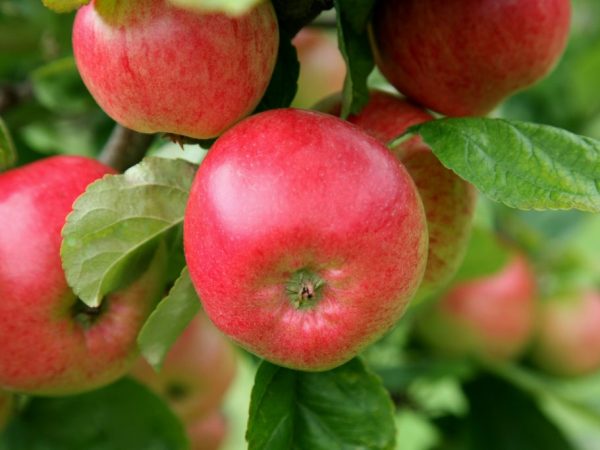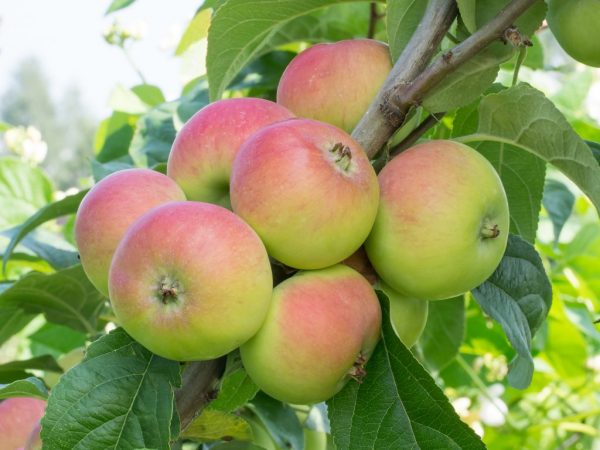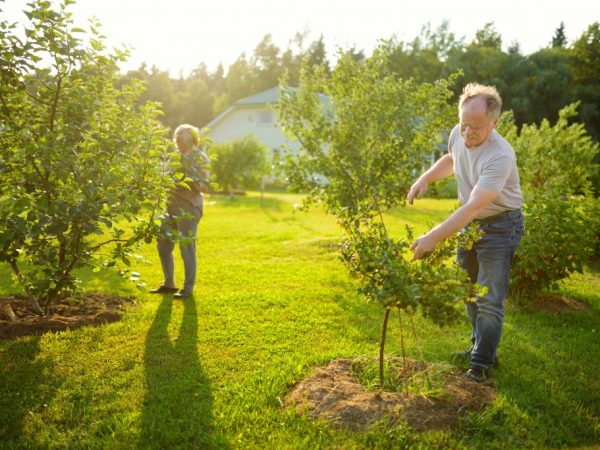Popular varieties of apple trees for the Leningrad region
New species and varieties of apple trees appear, which have an improved set of qualities. Trees can now be grown in gardens that are adapted to different environmental conditions. Currently, new varieties of apple trees have appeared for the Leningrad region, which is known for its unstable climate.

Popular varieties of apple trees for the Leningrad region
Selection of varieties by maturity
The varieties that can be used for planting in the Leningrad Region are distinguished by the timing of the ripening of the crop. The most popular are autumn types. These are universal apple trees, because the usual harvest of fruits usually takes place in September - October. These include:
- Antaeus;
- Arkhangelsk;
- Garland;
- Welsey.
Summer varieties of columnar apple trees for the Leningrad Region are very popular among gardeners. This is due to the fact that you can get the fruits before the first autumn frosts come, which can damage the crop.
Summer types include:
- Amicable - an early variety, can bear fruit already at the end of summer;
- Ostankino - will delight you with fruits in early September;
- President - is considered the fastest growing tree among all other columnar apple trees for the northwest regions. Its peculiarity lies in the fact that the harvest can be obtained in the same year when the planting was made;
- Medoc is an early variety. You can get fruits in mid-August with proper care.
Winter zoned varieties of columnar apple trees are not so common. This is due to the fact that after October, frosts very often develop in this region and a lot of precipitation falls.
Therefore, for such a climate, very resistant species are needed that will not die from sudden frost. These apple trees include Arbat - a late variety, the fruiting of which can come at the end of autumn.
The most delicious varieties
The description says that all columnar varieties have good fruit quality. Antey apples are large and juicy. Their peel is red with a small amount of green and yellow veins. The pulp is white, juicy, does not crumble. The taste is bright, moderately sweet.
Arbat differs from other varieties in the northwest in that its fruits are slightly flattened in shape. The color is a bit unusual. Experts describe it as saffron. On the fruits there is a slight dusting, like a tan, red or scarlet.
The apple tastes very rich, has a pronounced smell. The pulp is juicy, so this variety is great for making drinks.
Fruits of the Garland variety have a light shade. Their peel is usually pale green, with small blotches of red or pink. The fruits are tasty and sweet, the flesh is firm and juicy.
Apple trees Druzhnoe is a zoned variety. They were originally developed for this region. So St. Petersburg will be able to boast of a rich apple harvest. These early varieties have large yellow fruits, sometimes with a greenish tinge. Closer to autumn, apples may acquire a slight orange blush.
The flesh of the fruit is juicy, maybe a little sour, but quite sweet.
Ostankino is a dwarf variety. It is convenient to grow it in gardens where there is little space. Its specific feature is that the trunk has a large number of leaves. The fruits from this tree are large enough, sweet and tasty, and have a green color. The pulp has a pronounced aroma.
Variety President - these are low-growing trees with a lot of fruits on it. The fruit is bright, greenish-yellow in color, sometimes with a red coating. They have a pronounced aroma. The fruit tastes sweet.

Fruits from apple trees of columnar varieties are very tasty
Medoc belongs to the zoned varieties. They were specially designed for the harsh conditions in the northwest. The fruits from this tree are large, tasty and juicy, the pulp has a pleasant sweet and sour hue.
Welsey is a very special variety. Its description differs in that its fruits are very large, have an intense bright red color of the peel. The taste of the pulp has a pronounced strawberry hue.
Each gardener from the Leningrad Region can choose the variety, the fruits of which will suit his taste.
Disease Resistant Varieties
When choosing a tree for growing in the northwest, it must be borne in mind that the variety must be resistant not only to frost, but also to various diseases that can affect the culture. Breeders have crossed varieties for a long time, trying to ensure that the trees could withstand various ailments.
The most resistant species is Welsey. On its basis, breeders have improved many trees. Thanks to Welsey, more than 30 species of apple trees have appeared that may not be afraid of diseases. The variety is most resistant to immune scab.
This disease is characterized by the appearance of dark spots of keratinization on the skin. This does not affect the taste of the fruit, but significantly impairs its appearance. If apples are grown for home use, then there is nothing to worry about. But if they want to sell them, this can significantly reduce revenue.
Other varieties are resistant to this disease, but to a lesser extent: Zhukovka, Garland, President.
Choice for fruiting
Fruiting can vary in timing. Early ripening varieties are those from which fruits can be harvested after 2-5 years after planting. There are trees that need 7 or 8 years for this, but such trees are not found among the columnar - this is a feature of their type.
There are varieties that can bear fruit in the same year that it is planted. Such a variety among the columnar apple trees is the President. Other crops of this type can begin to bear fruit only 2-3 years after planting in the ground.
Differs from all the Welsey variety. Despite all its advantages, to get the first apples from it, you need to wait 4 to 5 years.
Some apple trees can bear fruit every year: President, Medoc, Ostankino.
The Welsey variety can produce one crop every 2 years. The rest of the species can bear fruit, depending on the care and maintenance.
If the gardener prefers not the speed and frequency of fruiting, but the size of the fruit, he should pay attention to the varieties characterized by large apples. These include - Antey, Medoc, Ostankino, Welsey.
Growing features
Columnar apple trees can be planted 2 times a year - in autumn and spring. A feature of the procedure in spring is the choice of the moment when the buds have not yet blossomed.
This is because the tree needs a lot of energy for good root growth. This cannot be achieved if at this moment the kidneys are developing.
In autumn, planting is carried out when the foliage has already fallen - this is a guarantee that the root system will take root in the ground. For apple trees to harden well in the ground, it is better to use seedlings up to 1 year old. Younger trees will not survive the cold season, while older trees are more difficult to adapt.
The pit should be spacious enough. Its diameter is usually 50 cm, the same depth should be. For planting a tree, it is better to use fertile soil. For columnar apple trees, the most suitable is a soil with sand and clay. If the characteristics of the land are different, you can artificially introduce these parts.

Apple trees need sunlight
In order for a tree to delight with beautiful fruits with a bright blush, it is necessary to plant it in gardens where there is a lot of sunlight. Without this, the fruit will be pale and dull, although it will not affect the taste.
Columnar dwarf apple trees do not tolerate draft well. It is better to place them where the winds are not particularly aggressive, especially from the north. It is necessary to ensure a sufficient supply of water from the groundwater, but their level should be at least 2 m - otherwise there will be too much moisture and the roots will begin to rot by winter.
It is better to take quality winter low-growing seedlings from trusted breeders in this region, so as not to accidentally plant a tree with diseases or pests.
For a successful landing, you must:
- plant quickly: the roots should not be outdoors for a long time - so they can dry out;
- the roots should be freely located in the prepared hole: do not bend or break them;
- the ground for filling the hole should be soft and loose, without lumps;
- if the seedling is small, it is better to tie it to a small peg;
- immediately after planting in the northwest, you need to water the apple tree with 2 buckets of water.
For convenience, you can plant trees in groups - summer and winter. It is better not to plant columnar apple trees one by one. There should be a distance of at least 0.5 m between the trees so that they do not interfere with each other during growth. If trimming is done, the distance can be made smaller.
Care
The columnar apple trees in this region are regularly watered. For young trees in warm weather, one bucket of water is enough once every few days, but in drought conditions, watering should be done much more often - once a day. With the onset of autumn, it is reduced and gradually stopped by winter.
The apple tree needs to be fed regularly - in spring and summer. In the spring, fertilizer must be applied twice. The best choice would be nitrogen preparations. In summer, both dressings are best done with urea.
You need to prune the tree when it reaches 3-4 years old. This is done in the fall, closer to winter, when the foliage falls. Pruning should be gentle.
Every spring and autumn, the tree is treated from pests with special solutions to prepare it for the flowering and fruiting period.
Columnar apple trees are convenient for growing even in regions such as the Leningrad region. They tolerate frost well and are resistant to pests. Many crops can be harvested from them, although many of them are dwarf or undersized.
Tree maintenance does not require any special skills, it is enough just to take care of watering on time. If all the required conditions are met, the culture will delight with a large number of fruits.

